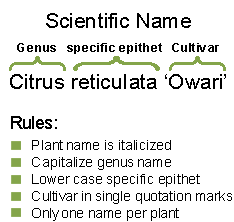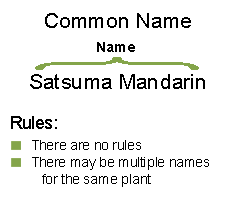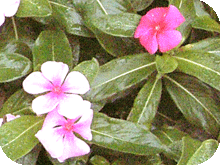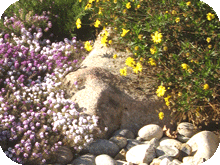
This mailer has been provided as an avenue to disperse information pertinent to public agencies and the landscape architecture profession in hopes of fostering greater understanding and collaboration. Topics address issues that affect the built environment within which we live.
Botanical Nomenclature (the naming of plants)
"Confusion now hath made his masterpiece!", William Shakespeare
Imagine a scenario where you are visiting a friend's home and see a striking display of blue flowers in his/her flower garden. After inquiring what flower it is, your friend replies, "it is a bluebell". You are so impressed with the display that you visit your local nursery the next day and confidently request they sell you a pot of "bluebells". After a confused look by the nurseryman, he asks, "which bluebell would you like?" and thus begins a long, confusing discussion about what you thought you saw in your friend's garden.
The common name "bluebell" is used for many plants including at least five different genus with differing sunlight, soil, water, and maintenance requirements. Thus using the name "bluebell" may lead to an entirely different outcome than you may expect. In fact if you were looking for a White Waterlily (Nymphaea alba) you might be interested to know that this plant has 15 common names in English, 44 names in French, 105 names in German, and 81 names in Dutch.1
In order to avoid local and international confusion related to plants, a botanical nomenclature was developed. The result of this naming classification is a single name for each plant. This name is referred to as a botanical name, species name, Latin name or scientific name.
Plant Classifications -
Plants are named according to a hierarchical system, similar to all other organisms on earth. For practical purposes this article only addresses the genus, specific epithet and cultivar classifications, as these are the names that are most commonly used in nurseries and catalogs. The figures below show the breakdown of a how a scientific name is formed with a genus, specific epithet and cultivar. A genus can be described as a group of plant species of one kind or with similar characteristics. Roses are a good example of this as there are hundreds of roses differing in size, shape and color available in the market, but they all have the same genus 'Rosa'. The specific epithet is a descriptor that further defines the differences between plants within the genus. The word "cultivar" is a term used for a cultivated variety of a plant. The cultivar descriptor is a name given to a plant within the same species that have been specifically propagated (or bred) for desirable traits. Desirable traits may include traits such as unusually bright red leaves in the fall or an unusually large flower in the spring.
The Latin Binomial -
The scientific name of a plant was first developed in 1753 by Linnaeus, a Swedish botanist.1 We have already discussed the components of the Latin binomial (or scientific name), however there are a few rules to remember when using this naming convention. The figures below show a few of the rules you should know for one of my favorite plants, the Japanese Mikan, or another common name the Satsuma Mandarin:



Scientific Names are "Clues"-
As discussed above, the naming of plants contain descriptors. These descriptors when studied carefully reveal plant characteristics that can help determine plant colors, forms, shapes, origins, growth patterns and interesting plant features. The following are examples of the types of clues found within scientific names:
albus = White; ruber = Red; compactus = Compact; contortus = Twisted; africanus = African Origin; riparius = Riparian; edulis = edible; officinalis = Medicinal; and grandi = Large or showy.2
These are just a few of the many descriptive clues that can reduce confusion in the landscape.
At the end of the day, the scientific name attached to a plant ensures that despite differences in language, background, and horticultural knowledge, everyone knows the plant chosen for the job is the same plant that goes into the ground.
1. Chatfield, Jim and Martin Quigley. "A Plant by Any Other Name". Tree Selection and Planting: A Collection of CUE Articles. International Society of Arboriculture. (2003):1-6. Print.
2. Brenzel, Kathleen. Sunset Western Garden Book. Menlo Park, CA. Sunset Publishing Company. 2001. Print.
The next time you need a Landscape Architect on your project, consider O'Dell Engineering's Landscape Architecture Department.
Services include:
- Park and Playground Design
- Recreational Facility Design
- Site Planning
- Streetscape Design
- Urban Design
- Commercial Design
- 3-D Visualizations
- Graphic Design
- Arborist Consulting
![]()



Author: Chad Kennedy, Landscape Architect
This informational article provided by O'Dell Engineering - 1165 Scenic Drive, Suite A, Modesto CA 95350
